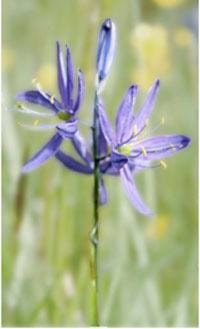It was back a few months, in the early summer when a the local camas plant (and those interested in it's continued survival) was featured in the Castlegar News.
A local effort was underway at Twin Rivers Park, with a number of volunteers taking part with the focus being the welfare of a significant number of camas plants.
The camus in question is an historical plant with very pretty blue flowers. Its relatively robust population in areas of the West Kootenay is somewhat of an anomaly.
The plant is seen as significant by a number of people, some, such as Brenda Beckwith (PhD Senior Lab Instructor (SLI) and Sessional Instructor, School of Environmental Studies at the University of Victoria) with a fair amount of influence. They're interested in the long-term well-being of the plant. Dr. Beckwith is an advisor with the West Kootenay Camas Project, and a welcome contributor to this piece.
Castlegar News:
Is the Kootenay camas population in any danger?
Dr. Beckwith:
The quick answer to this question is yes and no. I have only spent this year, a few days in May and one day in June, looking at these populations so that's what I'm basing this on, as well as my general knowledge of the ecology of the plant and what we're dealing with out here. So the yes part first. The camas populations I observed are located in, in part, old agricultural lands (oxbow), protected lands (Millennium), rocky bluffs, and riparian corridors. These are some of the most precarious locales in the region, for both ecological and political reasons. Some of the habitats are quite fragile, like the bluffs, and a site becoming a local teenager hangout or mountain bike trail would easily destroy it. If the local bylaws change and there is development down on the oxbow, if the hydrology changes, of the dams change water output, if the parks open up key areas for more public recreation opportunities; these could all be very detrimental to camas.
Dr. Brenda Beckwith is pictured below

The other side of the equation is the no answer. Camas is a plant that has had a very long and very intimate relationship with people, namely First Nations. I would go as far as to say, in many places, camas has co-evolved with resource management in the forms of selective harvesting and other cultivation practices, intentional water diversions to increase and maintain soil moisture and nutrition levels, and landscape scale burning. Because of this, camas is not only used to disturbance, in many cases, though largely dependent on the scale of disturbance, camas can thrive with or at least withstand it. It's really a testament to the lily itself that you have such amazing populations as you do. Given the history of the area and how localized the range is there, I'm surprised there still is as much as there is.
Castlegar News:
What may threaten it other than development?
Dr. Beckwith:
The main threat to camas and any species is habitat loss. Habitat degradation and fragmentation will also harm it but the extent may vary, depending on whether the sites can be or become well maintained and if restoration is occurring over the long term. A main threat that many people don't mention or simply fail to comment on is traditional management suppression (see first question). Camas can live quite well with some woody species as long as it continues to get adequate moisture through the growing season and light, but introduced grasses will eventually kill the population. So land management changes that would lead to increased dominance of non-native plants, especially pasture or agronomic graminoids, would not be advised.
Castlegar news:
Is there more of this type of work to be done here in the West Kootenays?
Dr. Beckwith:
Yes and yes. We clearly do not understand the complex ecology of camas in the region nor the full distribution (both current day and historical). There is a lot going on out there: is it a wetland plant? Is it an arid plant? Does it prefer the oxbow or Verigan's Tomb? We're hoping that we will receive funding to help us address some of these questions (and many more). The great work of the Kootenay Camas Project is helping bring this plant to light and help us see how important it is. Also, camas is only one of many highly significant resource plants that exist in the area; work on these plants, taking an eco-cultural approach, could benefit the plant populations but also promote greater awareness of the local First Peoples.
Castlegar News:
Is camas the sort of plant that can be cultivated and grown on a large scale?
Dr. Beckwith:
Yes, easily.
Castlegar News:
Does the plant have commercial value?
Dr. Beckwith:
As a garden plant and a plant for restoration, yes. It's a beautiful wildflower and native meadows are growing in popularity in people's yards (as opposed to conventional lawns, and, I should say, as opposed to the "native wildflower meadow mixes" that you can buy in the nursery – none of which (as far as I can tell) have any native species in them)! As a food plant, not yet. It takes a while to cook properly and will need some work with chef to get it right. This work should be done with local First Nations.
